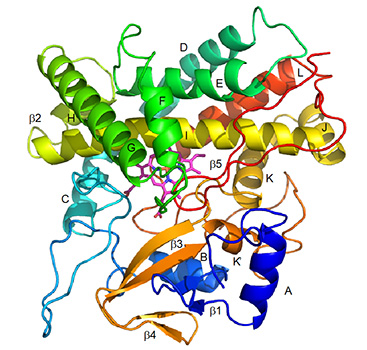 By Thomas Pochapsky, Professor of Chemistry & Biochemistry
By Thomas Pochapsky, Professor of Chemistry & Biochemistry
We don’t usually consider PineSol, Vick’s VapoRub and Lemon Pledge as food, but it is a good thing that some bacteria can. The active components of those products are terpenes, small organic molecules that are produced by evergreens to repel insects, promote wound healing and prevent infection. The bacteria that can use terpenes as food are a critical part of the forest ecosystem: Without them, the soil would rapidly become saturated with toxic terpenes. Members of the Pochapsky and Lovett laboratories in Chemistry and Biology are curious about what enzymes are involved in terpene metabolism. In particular, why would one bacterial strain feast on a particular terpene (camphor, for example) while ignoring others?
The first step in terpene breakdown by bacteria is often the addition of an oxygen atom at a particular place in the terpene molecule, providing a “handle” for subsequent enzymes in the breakdown pathway. The enzymes that catalyze these oxygenation reactions are called cytochromes P450. P450 enzymes perform important reactions in humans, including steroid hormone biosynthesis and drug metabolism and activation. Human P450s are targets for cancer chemotherapy and treatment of fungal infections. A specific inhibitor of P450 is a component of the AIDS “cocktail” treatment, slowing the breakdown of the other cocktail components so the drugs do not have to be taken as often.
Despite the importance and wide scope of the P450 enzyme family, we don’t know much about how a particular P450 goes about choosing a molecule to work on (the substrate) or where it will put the oxygen (the product). This is what the Brandeis labs are interested in finding out. What particular sequence of amino acids gives rise to the substrate/product combination of a given P450? Answers to this question will aid in drug design and bio-engineering projects.
The project employs multiple scientific techniques in order to get at the answers to these questions, including bacterial genome sequencing, messenger RNA transcription, enzyme isolation, activity assays, mass spectrometry and enzyme structure determination. As complicated as it sounds, though, the project lends itself nicely to undergraduate research: Three of the authors on this paper are undergraduates, Phillix Esquea ‘18, Hannah Lloyd ’20 and Yihao Zhuang ’18. Phillix was a Brandeis Science Posse recruit, and is now working with a Wall Street investment bank in NYC. Yihao is enrolled in graduate school at the University of Michigan School of Pharmacy, and Hannah Lloyd is still at Brandeis, continuing her work on the project. Even high school students got in on the act: Teddy Pochapsky and Jeffrey Matthews are both seniors at Malden Catholic High School, and collected soil samples used for isolation of terpene-eating bacterial strains. (One of the newly isolated bacterial strains is named in their honor, Pseudomonas strain TPJM).
“A new approach to understanding structure-function relationships in cytochromes P450 by targeting terpene metabolism in the wild.” Nathan R.Wong, Xinyue Liu, Hannah Lloyd, Allison M. Colthart, Alexander E. Ferrazzoli, Deani L. Cooper, Yihao Zhuang, Phillix Esquea, Jeffrey Futcher, Theodore M. Pochapsky, Jeffrey M. Matthews, Thomas C. Pochapsky. Journal of Inorganic Biochemistry. Volume 188, November 2018, Pages 96-101. https://doi.org/10.1016/j.jinorgbio.2018.08.006.







 By Thomas Pochapsky, Professor of Chemistry & Biochemistry
By Thomas Pochapsky, Professor of Chemistry & Biochemistry